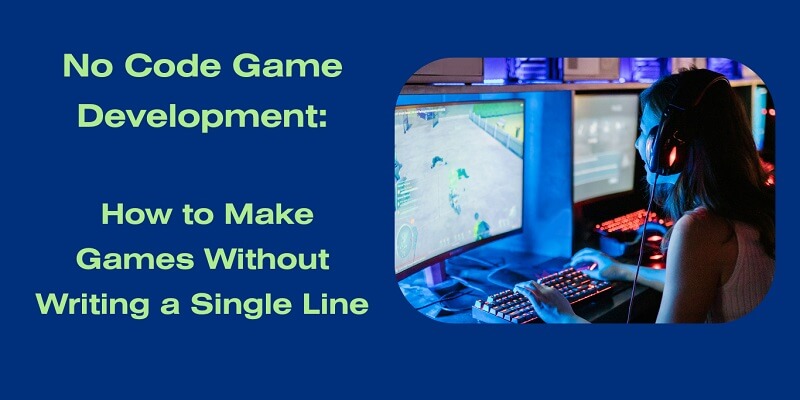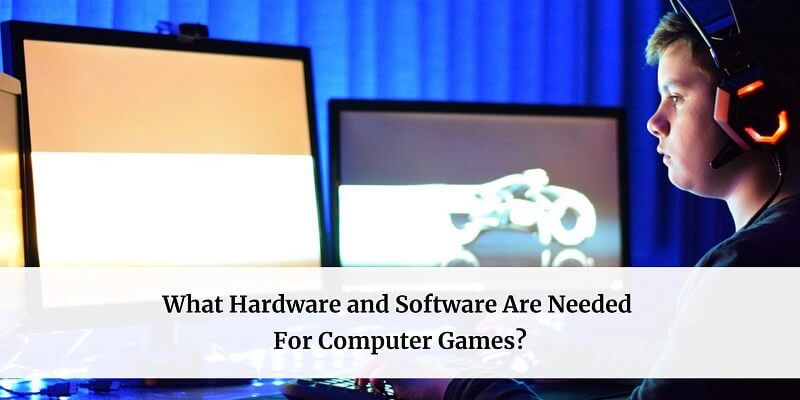No-code game development refers to the process of creating video games without writing any traditional programming code. Instead, developers use visual programming tools, drag-and-drop interfaces, and pre-built templates to design and assemble their games. This approach eliminates the need for extensive coding knowledge, making game development more accessible to individuals without a technical background.
The primary advantage of no-code game development is its low barrier to entry. Aspiring game creators can focus on the creative aspects of game design, such as storytelling, level design, and user experience, without being bogged down by complex programming languages. This approach empowers a wider range of people, including artists, designers, and enthusiasts, to bring their game ideas to life without relying on professional programmers.
No-code game development platforms typically provide a user-friendly interface where developers can select pre-built components, such as characters, environments, and game mechanics, and assemble them using intuitive tools. These platforms often offer a visual scripting system, which allows developers to define game logic and behavior through a series of interconnected nodes or blocks, rather than writing lines of code.
While no-code game development has limitations in terms of complexity and advanced functionality compared to traditional coding, it offers a viable solution for creating simple to moderately complex games, prototypes, and educational or experimental projects. It is particularly well-suited for individuals or small teams with limited resources or those who want to quickly validate their game ideas before investing in more extensive development.
Popular No-Code Game Development Platforms
The no-code game development space has seen a rise in popularity with several platforms catering to creators of all skill levels. Some of the most popular and user-friendly options include:
GameMaker Studio:
One of the pioneers in the no-code game development scene, GameMaker Studio offers a visual, drag-and-drop interface for creating 2D games. It provides a comprehensive set of tools and features, including built-in physics engines, sprite editors, and support for various programming languages like GML (GameMaker Language) for advanced customization.
Construct:
Designed with a focus on accessibility, Construct allows users to create games without any coding knowledge. Its event-based system simplifies the game development process, making it easy to define game logic and behaviors. Construct supports the creation of 2D games for various platforms, including web, desktop, and mobile.
GDevelop:
An open-source no-code game engine, GDevelop is known for its user-friendly interface and extensive documentation. It offers a visual event-based system for creating 2D games, with support for a wide range of game genres. GDevelop also includes features like physics engines, particle effects, and the ability to extend functionality through plugins.
These platforms typically provide intuitive interfaces, visual editors, and a wide range of pre-built assets and templates to kickstart your game development journey. They often include features like physics engines, sprite editors, and support for various programming languages for advanced customization. With their user-friendly approach and comprehensive toolsets, these no-code game development platforms empower creators of all skill levels to bring their game ideas to life without the need for extensive coding knowledge.
Getting Started with No-Code Game Development
No-code game development app builder are designed to be user-friendly and accessible to individuals without prior coding experience. However, like any new skill, there is a learning curve involved. While you don’t need to learn programming languages or write lines of code, you’ll need to familiarize yourself with the platform’s interface, tools, and workflow.
To get started, it’s recommended to go through the platform’s tutorials, documentation, and community resources. Many platforms offer step-by-step guides, video tutorials, and sample projects to help you understand the basics of game creation. Additionally, online forums and communities can be invaluable resources for seeking guidance, asking questions, and learning from experienced users.
The first step is typically to create an account on the platform and explore the available templates, assets, and game mechanics. Most platforms provide a visual interface where you can drag and drop elements, customize game objects, and define rules and behaviors without writing code.
Once you’re familiar with the platform, you can start building your first game by selecting a genre or template that aligns with your vision. Many platforms offer a wide range of game templates, from simple puzzles and platformers to more complex RPGs and strategy games.
As you progress, you’ll learn how to add characters, environments, sound effects, and gameplay mechanics using the platform’s tools. You can also customize the game’s user interface, menus, and settings to create a unique experience.
While no-code game development platforms are designed to be accessible, it’s important to be patient and persistent. Like any new skill, mastering the platform and creating compelling games may take time and practice. However, with the right resources and dedication, you can bring your game ideas to life without the need for traditional coding.
Game Genres and Types Suitable for No-Code Development
While no-code game development platforms offer a wide range of possibilities, certain game genres and types are particularly well-suited for this approach. Platformers, puzzlers, and casual games are among the most popular choices for no-code game development due to their relatively simple mechanics and gameplay loops.
Platformers are a classic genre that involves navigating a character through levels filled with obstacles, enemies, and collectibles. These games typically feature side-scrolling or vertical scrolling gameplay, making them a great fit for no-code development. Many no-code platforms offer pre-built assets and tools specifically designed for creating platformer games, allowing developers to focus on level design and gameplay mechanics.
Puzzle games are another excellent choice for no-code development. These games often revolve around solving logic-based challenges or manipulating objects to achieve a specific goal. Puzzle games can range from simple match-three games to more complex brain teasers, and they are well-suited for touch-based or mouse-driven interactions, which are common in no-code game development environments.
Casual games encompass a broad range of genres, including match-three, hidden object, time management, and more. These games are typically designed for short play sessions and are often targeted at a broad audience. Casual games are a great fit for no-code development because they often have straightforward mechanics and a focus on addictive gameplay loops rather than complex graphics or systems.
Beyond these popular genres, no-code game development platforms can also be used to create a variety of other game types, such as educational games, simulation games, and even simple role-playing games (RPGs). The key is to understand the strengths and limitations of the no-code platform you’re using and to choose a game genre or type that aligns with those capabilities.
Building Your First No-Code Game
Creating your first game with a no-code platform is an exciting and rewarding experience. Most no-code game development tools provide a user-friendly interface with drag-and-drop functionality, allowing you to design and build games without writing a single line of code.
The process typically starts with choosing a game template or starting from scratch. Templates offer pre-designed game elements, characters, and environments, which you can customize to your liking. If you prefer to build from the ground up, you’ll have the freedom to create every aspect of your game, from the background to the characters and their behaviors.
Once you’ve selected your starting point, it’s time to dive into the game design process. This usually involves arranging game objects, setting up scenes or levels, and defining rules and interactions. Many no-code platforms offer a visual editor where you can drag and drop game elements, adjust their properties, and establish relationships between them.
As you progress, you’ll likely encounter options to add animations, sound effects, and music to enhance the gaming experience. Some platforms even allow you to integrate physics engines, enabling realistic object interactions and movements within your game.
Testing and debugging are crucial steps in the development process. Most no-code tools provide a preview mode or a built-in testing environment, allowing you to play and test your game as you build it. This helps identify and resolve any issues or bugs before publishing your game.
When you’re satisfied with your creation, the final step is to publish or deploy your game. No-code platforms often offer various deployment options, such as exporting to popular app stores, embedding your game on a website, or sharing it directly with others.
Throughout the process, many no-code game development platforms offer extensive documentation, tutorials, and community support to guide you through every step. With practice and experimentation, you’ll gain confidence and skills in creating engaging and entertaining games without the need for traditional coding knowledge.
Advanced Features and Customization
While no-code game development platforms are designed to be user-friendly and accessible, they often offer advanced features and customization options for those looking to create more complex and unique gaming experiences. These tools allow you to push the boundaries of what’s possible without writing a single line of code.
One of the most powerful features in many no-code platforms is the ability to create custom logic and rules using visual programming interfaces. These interfaces use drag-and-drop components, flowcharts, or node-based systems to define game mechanics, behaviors, and interactions. This approach makes it easier to design intricate gameplay systems, such as AI opponents, physics simulations, or procedural content generation, without the need for traditional programming.
Another advanced feature commonly found in no-code game engines is the ability to import and integrate custom assets. This could include 3D models, audio files, particle effects, or even pre-written code snippets. By allowing users to bring in their own assets, these platforms open up a world of possibilities for creating truly unique and visually stunning games.
Many no-code platforms also offer extensive customization options for game user interfaces (UIs) and heads-up displays (HUDs). With intuitive design tools, you can create immersive and user-friendly interfaces tailored to your game’s specific needs. This could involve creating custom menus, overlays, or even implementing advanced UI features like mini-maps or real-time data visualizations.
For those looking to create more complex and large-scale games, some no-code platforms offer advanced world-building and level design tools. These tools often include features like terrain sculpting, procedural generation, and advanced lighting and rendering capabilities, allowing you to create vast, detailed game worlds without the need for complex 3D modeling or programming skills.
Finally, many no-code game development platforms offer integration with external services and APIs. This could include features like online multiplayer functionality, leaderboards, achievements, or even integration with popular game distribution platforms. By leveraging these integrations, you can create games with advanced online features and reach a wider audience without the need for extensive backend development.
Monetization and Publishing Options
Monetization is a crucial aspect of any game development endeavor, and no-code game development is no exception. With the right strategies, developers can generate revenue from their games and potentially turn their passion projects into sustainable businesses. One of the most common monetization models for no-code games is the freemium approach, where the base game is free to play, but additional features, levels, or in-game items are available for purchase. This model can be implemented through in-app purchases, subscriptions, or advertisements.
Another popular monetization strategy is the pay-to-play model, where users must purchase the game upfront before gaining access to its content. This approach can be particularly effective for premium or niche games that offer a unique and compelling experience. Alternatively, developers may opt for a hybrid model that combines elements of both freemium and pay-to-play approaches.
Once a game is ready for release, developers have several publishing options to consider. Many no-code game development platforms offer built-in publishing capabilities, allowing developers to easily deploy their games to various app stores or web platforms. Additionally, there are dedicated game publishing platforms and marketplaces specifically designed for no-code games, providing developers with a centralized hub to showcase and distribute their creations.
It’s important to note that while no-code game development simplifies the technical aspects of game creation, successful monetization and publishing still require careful planning, marketing, and a deep understanding of the target audience’s preferences and behaviors. Developers should research and analyze market trends, competitor offerings, and potential revenue streams to develop an effective monetization and publishing strategy.
Pros and Cons of No-Code Game Development
Pros:
- Accessibility: No-code game development platforms democratize game creation by making it accessible to individuals without coding skills, empowering a broader range of people to bring their ideas to life.
- Rapid Prototyping: With visual interfaces and pre-built components, no-code tools allow for quick prototyping and iteration, enabling developers to test concepts and gather feedback more efficiently.
- Cost-Effective: Compared to hiring professional developers or purchasing expensive software licenses, no-code platforms often have lower upfront costs, making game development more affordable for indie creators and small teams.
- Faster Time-to-Market: By eliminating the need for extensive coding, no-code tools streamline the development process, allowing games to be built and released more quickly, which is crucial in the fast-paced gaming industry.
Cons:
- Limited Complexity: While no-code platforms are constantly evolving, they may still have limitations in terms of the complexity and depth of games that can be created, especially for highly intricate or resource-intensive projects.
- Customization Constraints: Pre-built components and templates can restrict customization options, making it challenging to achieve unique or highly specialized gameplay experiences.
- Performance and Scalability Issues: Depending on the platform, no-code games may face performance bottlenecks or scalability challenges, especially for games with high computational demands or large user bases.
- Vendor Lock-in: Reliance on a specific no-code platform can lead to vendor lock-in, making it difficult to migrate projects or switch platforms if needed, potentially limiting future flexibility.
- Limited Control and Transparency: With no-code tools abstracting away the underlying code, developers may have less control and visibility into the inner workings of their games, making advanced debugging or optimization more challenging.
While no-code game development offers significant advantages in terms of accessibility, cost-effectiveness, and rapid prototyping, it’s essential to weigh these benefits against potential limitations in complexity, customization, and performance. Ultimately, the choice between no-code and traditional coding approaches should be based on the specific requirements and goals of each game project.
Success Stories and Inspiring Examples
From indie developers to large companies, no-code game development has enabled creators of all backgrounds to bring their game ideas to life without the need for extensive coding knowledge. Here are some inspiring success stories that showcase the potential of no-code game development:
Untitled Goose Game (House House):
Developed by a small team using Game Maker Studio, this charming and innovative stealth game took the gaming world by storm in 2019. With its quirky premise of playing as a mischievous goose, Untitled Goose Game won numerous awards and became a cultural phenomenon, proving that no-code tools can produce highly engaging and creative experiences.
Flappy Bird (Dong Nguyen):
Developed by a single developer using GameSalad, Flappy Bird became a viral sensation in 2013, raking in millions of downloads and sparking a global craze. Despite its simple mechanics and retro graphics, the game’s addictive gameplay and challenging nature captivated players worldwide, demonstrating the potential for no-code games to achieve massive success.
Bury Me, My Love (The Pixel Hunt):
This unique narrative game, created using Twine, an open-source tool for interactive fiction, tells the emotional story of a Syrian refugee’s journey to Europe through text messages. Bury Me, My Love received critical acclaim for its powerful storytelling and innovative use of a no-code platform, showcasing the versatility of these tools for creating immersive and thought-provoking experiences.
Ludo King (Gameberry Labs):
Developed using Construct 3, Ludo King is a modern take on the classic board game Ludo, enjoyed by millions of players worldwide. Its success demonstrates how no-code tools can be used to create engaging and accessible games that appeal to a broad audience, while also highlighting the potential for monetization and scaling.
These success stories serve as inspiration for aspiring game developers, demonstrating that with creativity, dedication, and the right no-code tools, anyone can create engaging and successful games without the need for extensive coding knowledge.
The Future of No-Code Game Development
No-code game development is still a relatively new concept, but it’s rapidly gaining traction and is poised for significant growth in the coming years. As the technology behind these platforms continues to evolve, we can expect to see more advanced features and capabilities that will further democratize game creation.
One of the most exciting prospects is the integration of artificial intelligence (AI) and machine learning (ML) into no-code game app maker platforms. AI could be used to generate game assets, such as characters, environments, and even storylines, based on user inputs and preferences. This would not only speed up the development process but also open up new creative possibilities for non-technical users.
Additionally, as cloud computing and edge computing technologies advance, we may see no-code game development platforms that can leverage these resources to create more complex and resource-intensive games. This could allow for the development of games that were previously only possible with traditional coding methods.
The rise of no-code game development could also have a significant impact on the gaming industry as a whole. By lowering the barriers to entry, it could lead to a surge of new and innovative games from creators who may not have had the opportunity to develop games before. This increased competition could drive the industry to new heights, pushing established game developers to continue innovating and improving their offerings.
Furthermore, no-code game development could open up new avenues for game monetization and distribution. With the ability to create games quickly and easily, developers may explore new business models, such as subscription-based gaming platforms or crowdfunding campaigns for game development.
Overall, the future of no-code game development looks bright, with the potential to revolutionize the way games are created and consumed. As the technology continues to evolve and more people embrace this approach, we can expect to see a diverse and exciting range of games that push the boundaries of what’s possible in the gaming world.



